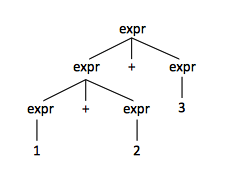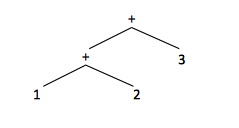Formal Languages and Translators
Internal
Overview
Compiler
Interpreter
Lexical Analysis
Regular Expressions
Finite Automata
Token
Syntax Analysis (Parsing)
Grammar
A context-free grammar has four components:
- A start symbol.
- A set of terminal symbols, or terminals, which are the elementary symbols of the language defined by the grammar and they are sometimes referred to as tokens.
Derivation. The leftmost derivation. The rightmost derivation. A string of the language is generated or derived from the start symbol of the grammar.
Production
Production head
Production body
Nonterminal
The terminal strings that can be derived from, or generated by the start symbol of the grammar from the language defined by the grammar. Conversely, a string of the language defined by the grammar is any terminal string that can be derived from the start symbol of the grammar. Another definition of a language generated by a grammar is the set of strings that can generated by some parse tree.
ε
Left-Recursive Grammar
Relationship to top-down parsers.
Backus-Naur Form (BNF)
Extended Backus-Naur Form (EBNF)
Parse Tree
A parse tree is a graphical representation of how the start symbol of a grammar derives a string in the language defined by the grammar.
The root of the parse tree is labeled by the start symbol. Each interior node of a parse tree represents the application of a production and it is labeled with the name of the nonterminal that is the head of the production. The children node are labeled, from left to right, by the symbols in the body of the production. While is being constructed, the leaves of a parse tree may represent terminals and nonterminals, which at any moment, if they are read from left to right, they constitute the yield or the frontier of the tree, and it is also referred to as a sentential from of the grammar. After a string in the language defined by the grammar is fully parsed, each leaf is labeled by a terminal or by ε.
A parse tree does not contain the information that reflects the order in which productions are applied to replace nonterminals. It is customary to produce parse trees by always producing the leftmost (or rightmost) derivation. Each parse tree has associated with it a unique leftmost and an unique rightmost derivation.
Parse trees are sometimes called concrete syntax trees.
For the following grammar:
expr → expr + expr | NUMBER
and the string "1+2+3", the parse tree is:
(Abstract) Syntax Tree
The abstract syntax tree, also referred to as syntax tree, represents the hierarchical syntactic structure of the parsed content, by depicting significant programming constructs. For example, in case of an expression that involves an operator, the fragment of the syntax tree that represents the expression has a node that represents the operator, and its children represent the operands. In general, any programming construct can be handled by marking up an operator for the construct and treating the semantically meaningful components of that construct as operands.
A syntax tree resembles a parse tree to a certain extent. The difference is that for a syntax tree, the internal nodes represent programming constructs, while for parse tree, the internal nodes represent nonterminals. Many nonterminals of a grammar represent programming constructs, but others are intermediate "helpers" of some sort, for example representing terms, factors or other variations of expressions. Examples of productions that are not represented in a syntax tree are expr → term or ε-productions rest → ε. These helpers are dropped into a syntax three. That is why sometimes a parse tree is called a concrete syntax tree.
The corresponding syntax tree of the parse tree represented above is:
Parsing
The process of finding a parse tree from a given string of terminals is called parsing the string.
For a top-down parsing strategy, where the parser starts to build the parse tree from the root, and assuming that the parser just starts to match the nonterminal 'M', as shown below, the parser has a choices as to which one of the alternative productions for the nonterminal to choose - in case there are more than one productions.
M → N P Q | X Y Z
Operator Precedence
Operator Associativity
Parser
Top-Down Parser
A top-down parser is a parser that employs a strategy where it first looks at the highest level of the parse tree and works down the parser tree by using the rewriting rules of the formal grammar. The top-down parser discovers the parse tree starting from the top and incrementally works its way first downwards and then rightwards. Unlike a bottom-up parser, the top-down parser eagerly decides what a construct is much earlier, when it has only scanned the leftmost symbol of that construct and has not yet parsed any of its parts.
If a language grammar has multiple rules that may start with the same leftmost symbols but have different endings, that grammar can be efficiently handled by a deterministic bottom-up parser, but cannot be handled top-down without guesswork and backtracking - so bottom-up parsers handle a somewhat larger range of computer language grammars than top-down parsers.
A recursive descent parsers is a top-down parser build from a set of possibly mutually recursive procedures, where each such procedure usually implements one of the productions of the grammar. In consequence, the structure of the resulting program closely mirrors that of the grammar it recognizes. A predictive recursive descent parser is a recursive descent parser that does not require backtracking, it is called a predictive parser.

